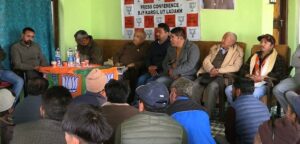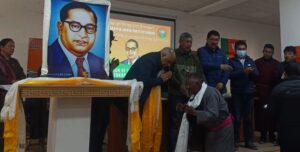NDS ice hockey rink: Ladakh’s pride seeks more glory after KIWG debut
Leh (Ladakh) [India], February 9 (ANI): The Nawang Dorjay Stobdan Sports Complex ice rink in Leh, situated amidst the majestic Himalayas, made a historic debut with the just-concluded first chapter of the Khelo India Winter Games 2024. This rink is India’s first natural ice hockey arena built to international standards.
Popularly known as the NDS ice hockey rink, it stands as a testament to Ladakh’s dedication to sporting infrastructure. With a seating capacity of 3000, it offers spectators a front-row seat to the exhilarating clashes of ice hockey talent. Spanning an impressive 60 meters by 30 meters, the Olympic-sized rink’s dimensions adhere to international standards, ensuring a level playing field for athletes and teams alike.
Having established a foothold during the Khelo India Winter Games, there are bigger plans around the NDS rink. Moses Kunzang, director, District Youth Services and Sports, UT Ladakh, says, “We are looking ahead to organizing similar championships in the future. In fact, within the next 2-3 years, we aim to incorporate snow skiing alongside ice hockey and ice skating. Undoubtedly, such championships will play a pivotal role in promoting winter tourism and winter sports in Ladakh.”
Additionally, the Ladakh administration is in the process of constructing 20-30 ice hockey rinks of international standards across Ladakh, though seating capacity may vary. One such rink is already under construction in Kargil. It is learnt that the UT administration has earmarked Rs 41.72 Crores under the Special Development Package and another Rs 9.66 Crores from other schemes to complete the NDS rink.
Most of the matches of the Khelo India Winter Games were held at NDS Stadium. This national-level event provided a platform for talented athletes from across states and union territories to showcase their skills and spirit of sportsmanship. For Ladakh, this event symbolized a significant leap forward, offering its athletes the opportunity to shine on a national stage and inspire generations to come.
Sonam Chhering, the captain of the Himachal Pradesh men’s ice hockey team says, “It was a great experience for all of us. We’ve participated in numerous tournaments, but this one stands out as the best, owing to Ladakh’s provision of a proper ice hockey rink and excellent ice conditions.”
Amidst Ladakh’s commitment to winter sports, a Sports Authority of India-supported Centre of Excellence is expected to nurture talent and foster excellence across diverse sporting disciplines like boxing, archery and athletics in the region. But Ladakh can really be proud of its under-construction NDS rink, which hosted the KIWG ice hockey final on February 6 between two powerhouses in the sport in India – Army and ITBP.
The NDS rink is still far from completion but the basic requirements to stage matches are there. The administration has received some support too. A dasher board, a crucial component for the safety of players around the perimeter of the rink, has been gifted by the American Ice Hockey Association and the Canadian High Commission. The dasher board was procured from Austria, a testament to the global solidarity and support for the growth of winter sports in India.
Reflecting on Ladakh’s sporting journey, Noney Wangchuk, general secretary, Ice Hockey Association of Ladakh, recalls Ladakh’s remarkable feat in 2016, where the Chibra village of Pangong set a Guinness World Record by hosting an ice hockey event at unprecedented altitudes.
Wangchuk highlights the pivotal role played by the dasher board in realizing Ladakh’s sporting aspirations, acknowledging its considerable expense yet invaluable contribution to the region’s sporting legacy.
Stanzin Angchuk, Ladakh men’s ice hockey captain says, “Previously, we have played in Gulmarg which lacks proper facilities such as changing rooms and bench for the players and we had to sit on snow. Recently, we were in Kaza to participate in the national championships, there’s a huge difference in both the championship in terms of management, rink, maintenance of ice and overall.”
“Here, we have seen the Ice Hockey Association and other Club members working so hard till 2-3 am in the morning to maintain the ice. We get inspired and encouraged to see them and also enjoy playing,” said Angchuk, adding that NDS can now dream of hosting international events in future.
“We are eagerly looking forward to participate in international games hosted in Ladakh. The Challenge Cup of Asia operates on a rotating basis, affording Ladakh the opportunity to compete when we have access to a suitable rink,” he pointed out.
Talking about the difference between a natural and artificial ice, Tsewang Choskit, the captain of Ladakh’s women’s ice hockey team, said: “There’s huge a difference between natural and artificial ice. In 2016, we participated in Women Challenge Cup of Asia in Taipei China representing India. At that time, we saw artificial ice hockey rink for the first time and we were not able to control our skates. We were used to playing on natural ice which is hard.”
Year-round training is one the major problems with winter sports in India. Lack of all-weather facilities across the country is seen as a major impediment by players and officials.
“We belong to a high attitude area and we have a very good stamina as compared to others. The only thing we need to focus is to practice throughout the year and for that we need infrastructure,” said Choskit, adding, “We need support in terms of the equipment as they are very expensive.”
Wangchuk agrees. He emphasizes on converting the opportunity given by KIWG to something more substantial. He suggested a proactive step forward by completing and operationalizing the NDS rink to ensure year-round functionality. Wangchuk proposed leveraging natural ice for winter play and artificial ice for summer matches, extending the playing season beyond the current limited span of two-three months.
Rajat Malhotra of the Ice Hockey Federation of India, said, “The international standard is whenever you play a game, after every period, you have to resurface the ice and water the ice for 10-20 minutes. That’s not possible over here. In artificial rinks, you have chilling facilities and it doesn’t take time to resurface. When this rink will be shifted to all season, this will be the best facility.” Malhotra added that more such rinks were needed for the development of the sport in India.






